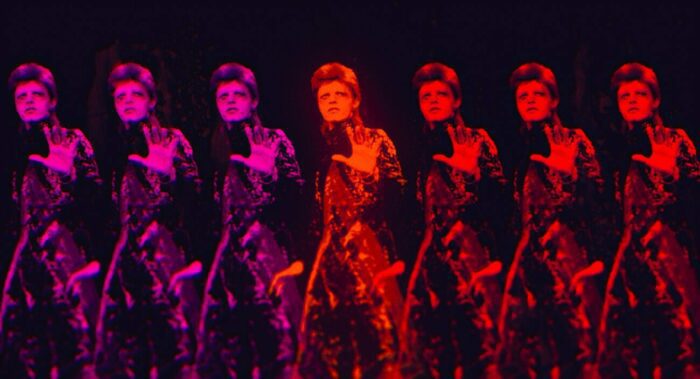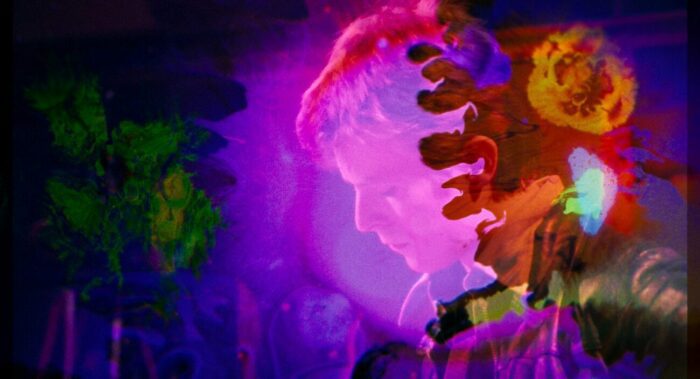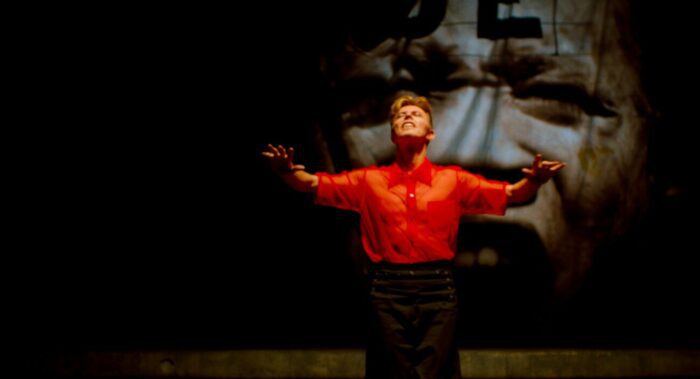Brett Morgen’s spectacular new documentary Moonage Daydream is aimed clearly at all you Pretty Things, Young Dudes, Heroes, and Rebel Rebels—and not, by any means, at any Absolute Beginners in the crowd. If that opener made perfect sense to you, you are all in for a kaleidoscopic, kinetic ride with the spaceman himself, slipping with him in and out of his various guises as he teases and tantalizes his audience with his evocative music, provocative visuals, and intelligent self-reflection.
But if you know David Bowie only by a handful of hits, Morgen’s eclectic, poetic, nearly non-narrative approach may seem more confounding than illuminating. Moonage Daydream is a documentary selectively assembled from the artist’s performances, music, and interviews over a nearly five-decade-long career, and illustrated with cinematic imagery from across the 20th century. What you will not see or hear is any of the traditional stuff on which rock-docs rely: that is to say, no reflective interviews from those who knew the man or studied his work; no nondiegetic titles or text labeling content or locations; no exposition, really, of any sort; and no narrative framing devices leading viewers through sections or sequences save for a loose grouping of the artist’s various personae.
In other words, Morgen has set himself some very strict self-imposed conditions here, and the result is challenging, but spectacularly immersive. First and foremost, there is Bowie’s impeccable, impossibly wide-ranging pop music. Here, even, Morgen largely prefers the deep cuts to the most recognizable hits. There’s no “Rebel, Rebel,” “Fame,” “Young Americans,” “Golden Years,” “Under Pressure,” or “China Girl.” Even “Changes” is left to the very last minutes of the end credits—where it makes for a touching and wholly appropriate elegy to Bowie’s chameleonic nature. But there’s plenty to satisfy, including live versions of “Jean Genie” (with Jeff Beck and an apparently impromptu bit of “Love Me Do”) as well as “Space Oddity,” “Starman,” “Modern Love,” “Ashes to Ashes,” “Aladdin Sane,” and a sublime version of his “Heroes.”

While focusing primarily on Bowie’s music, much of it presented in performance from Bowie’s Ziggy Stardust, Diamond Dogs, Stage, Serious Moonlight, Outside, and Earthling tours (some, not all, seen before in prior documentaries), Moonage Daydream largely eschews any overt narrative structure. Ziggy Stardust will precede the Thin White Duke, but Morgen is largely uninterested in simple chronology, preferring instead more random, even free association of sound and image, resulting in a beautifully cacophonic, chaotic montage. The cinematic imagery accompanying Bowie’s songs runs the gamut of modern art-pop cinema: from A Trip to the Moon, The Cabinet of Dr. Caligari, Nosferatu, Metropolis, and Un Chien Andalou, to Frankenstein, Triumph of the Will, The Wizard of Oz, Fantasia, The Red Shoes, Top Hat, and The Seventh Seal, to 8-1/2, In the Realm of the Senses, Barbarella, 2001: A Space Odyssey, A Clockwork Orange, Blade Runner, The Wall, and Run Lola Run—in ways that make intellectual sense and lend a vibrant poignancy to the music. You won’t need a PhD in cinema studies to appreciate Morgen’s visuals, but it won’t hurt, either.
Those visuals, along with a good deal of footage from Bowie’s personal archive, are interrupted for occasional interviews the artist conducted with Dick Cavett and others—material which forms the only narration of sorts in the film. (The uneven voice-audio quality didn’t get the same lavish restoration treatment afforded The Beatles in Peter Jackson’s Get Back.) Bowie’s musical personae–androgynous, ambiguous, outlandish—may have veered towards the outrageous, but Bowie was a thoughtful, learned, Renaissance man of sorts, a multimedia artist well versed in culture and politics, and his own commentary makes for a more insightful guide through his own life stages than any film critic or contemporary colleague’s might.

Morgen’s access to Bowie’s archives encompasses an extraordinary treasure-trove of materials, from hours of unseen footage to Bowie’s own considerable output of personal artwork and poetry. According to the film’s press materials, he then spent some four years assembling the film and another 18 months designing the soundscape, animations, and color palette: Morgen is credited as the writer, director, producer, and editor for the film as well as the creator of its “Musical Mash-Ups,” as they are credited, with support from Supervising Sound and Music editor John Warhurst, Sound and Music Editor Nina Hartstone, First Assistant Editor Alexandre Martin, and Animation and Graphics Coordinator Alexandre Martin. The result of his and their efforts is nothing less than a spectacularly idiosyncratic work that brings Bowie’s vision—and his was always an intensely visual artistry accompanying his music—back to life.

Morgen’s documentary career has often focused on revealing personality through imagistic association. That’s exactly the point of both his 2015 Kurt Cobain: Montage of Heck and his earlier Robert Evans documentary, The Kid Stays in the Picture, the film that brought him international acclaim for its dizzying animations of still photos and Evans’ own voice (which he’d recorded for the audiobook version of his memoir by the same name). Both, figuratively and for their running time, brought their subjects (back) to life with their uncanny montages of archived images and recordings.
And although Moonage Daydream doesn’t aim to tell a chronological story, it nonetheless concludes with a spectacular resurrection sequence. It’s as if, through Morgen’s masterful editing, Bowie speaks directly to us, his fans, from beyond the grave and somewhere in outer space where he belongs, before bringing his music back, somehow, magically, transformatively, to an enraptured earthbound audience rocking out to “Sound and Vision”—exactly where his art resides. We tend to think of documentary as primarily a forensic art form, to borrow Aristotle’s term, in its examination of the past; but this sequence, and Moonage Daydream as a whole, works its magic in the epideictic realm instead, its animations landing Bowie back on Earth in our troubled present—where he is, in our increasingly troubled times, ever the more welcome.
Moonage Daydream opens in theaters Sept. 16, 2022.



